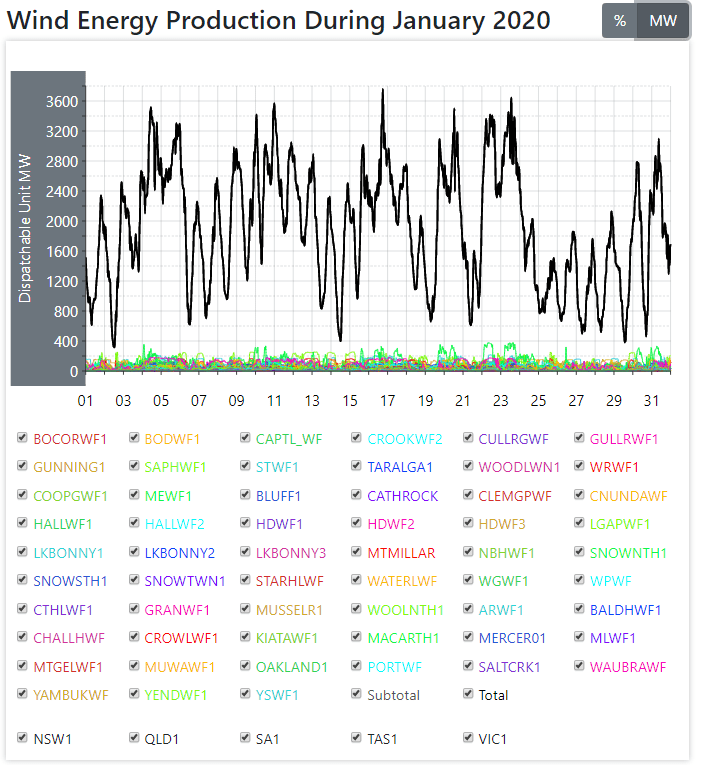The coronavirus is hitting Australia’s economy, but it will pass; whereas, its self-inflicted renewable energy calamity is here to stay. Where the former was unforeseen and fatal for a few, the latter was perfectly predictable and will have calamitous effects for the many, and for generations to come.
What’s left of Australia’s manufacturing and mineral processing industries is literally on life support. Those industries now suffer the world’s highest power prices, thanks to an obsession with heavily subsidised and chaotically intermittent wind and solar. Then, there’s the Third World power rationing they have to contend with, which coincides with calm and/or cloudy weather and sunset. The clowns that hijacked Australia’s power supply use the euphemism “demand management”.
The Federal government’s Large-Scale Renewable Energy Target was designed to direct $60 billion in subsidies to wind and solar, with the natural consequence being that conventional generators would be unable to compete with subsidised wind and solar.
No one in government and industry should be surprised that the operators of coal-fired power plants are struggling; that was precisely what was intended by the LRET, and every other punitive mandate, target, soft loan and government contract that’s been engineered to favour wind and solar power which would, otherwise, have no commercial value.
Marghanita Johnson heads up the Australian Aluminium Council, which has identified the mortal threat its members and their employees face as a result of Australia’s wind and solar obsession.
Energy plan failure risks ‘catastrophe’
The Australian
Greg Brown
17 March 2020
There could be “catastrophic” power outages at smelters unless a coherent national energy plan is developed before summer, the aluminium industry has warned.
Australian Aluminium Council executive director Marghanita Johnson said the industry of 17,000 workers could not afford another year of policy uncertainty, declaring the electricity grid needed more baseline power to balance intermittent renewables.
Ahead of a meeting between state and federal energy ministers on Friday, Ms Johnson said renewables and battery storage could not power heavy industry if coal-fired power stations closed.
“For the grid as a whole, it is not a one or two-year problem in terms of the transition, but we definitely have some challenges we need to face ahead of next summer in terms of stability in the grid. If there is a catastrophic outage, we will see a catastrophic outcome,” she said.
“The whole electricity sector had a challenging summer and aluminium obviously is at the frontline.
“We are interested in timely reforms that will help ensure that as we go into the next summer, we don’t face the same sort of challenges.”
The federal government is investigating extending the life of the Liddell coal-fired power station in the NSW Hunter Valley three years beyond its closure date in 2023.
There is a concern in government ranks that the closure of the power station, which powers the Tomago smelter, will cause a shortfall of baseline energy and should be delayed until Snowy Hydro 2.0 is fully operational.
Ms Johnson said she would be concerned about the closure of “any major generator” until there were replacement power sources.
“Most things in the current pipeline are a couple of years away,” she said. “So new interconnectors are a couple of years away. Snowy 2.0 is probably a bit more like three to five years away. We need to be really careful. You can’t replace something that has firming capacity with intermittent generation.”
Alcoa’s aluminium smelter in the Victorian town of Portland suffered two major outages over summer, while the Tomago smelter was forced to reduce output because of concerns about power shortages.
Rio Tinto chief executive Jean-Sebastien Jacques said the company was reviewing the future of its smelter operations because of high energy prices and instability in the grid.
Rio controls the Bells Bay smelter in Tasmania and the Boyne smelter in Gladstone and is the major shareholder of Tomago.
The Council of Australian Governments meeting between Energy Minister Angus Taylor and his state counterparts will be conducted via teleconference and discuss how the market needs to respond to the coronavirus crisis.
Ministers will also discuss how to increase reliability into the system, with Energy Security Board chair Kerry Schott to provide an update on the design for a new market framework to commence after 2025.
Ms Johnson said a transition to a low-emissions economy that rushed renewables into the system risked causing power failures to smelters, which could drive them out of business.
She called for the construction of new gas-fired power stations and the better use of existing coal plants.
“At the moment, the batteries aren’t big enough and won’t be big enough,” she said.
The Australian



Hi STT.
As if on cue, as the best possible response, to better illustrate the pleas made by the Australian Aluminium Council in the article from The Australian above, total Wind Farm output on the Eastern Australian grid, yes, the total, fell to below 200 MW and stayed there for the entire time during the period 11:20 AM and 13:40 PM last Saturday, 21 March 2020, that is, just 4 days after the article above was published in The Australian. That performance is less than pathetic.
For those readers who might still like to think that STT or myself are “cherry-picking” the data by looking at it in this way, might I suggest that they take a look at any monthly chart of wind farm performance at anero.id/energy/wind-energy, (when I last checked, anero.id allows you to look at such data all the way back to early 2014). There are very few months there that do not show the multiple dips to low, or even negative, values, being similar to the monthly chart presented here by STT.
Consider: and as STT has been saying for years now, if the grid was 100% powered by wind, each of these dips to such low values would result in a grid-wide blackout. How many such blackouts per year should we tolerate? The answer is of course a no-brainer: even a one-in-10-year grid-wide blackout is a totally unacceptable frequency, let alone multiple times each year.
Returning to the article quoted above: that the ED of the Australian Aluminium Council continues to adopt a polite, diplomatic, even pleading, tone is beyond me. To countenance for even a moment the idea of the use of batteries as a replacement for dispatchable generation to supply the base load is simply laughable.
In the face of the actual performance of this intermittent nonsense being served up as “real” generation, I suggest that she should be battering down the door of the Energy Minister’s office, demanding the building of new, real, fully dispatchable 24/7, generation, and right now.
Excellent work, STT,
Paul Miskelly
Thanks Paul. As the late Alby Schulz put it: “the only reason that they’re not rioting in the streets, is that they have no idea what’s going on”.
Reblogged this on ajmarciniak.
When it comes to the burning question of battery fire safety, those promoting wide scale use of lithium batteries are strangely quiet when asked about the propensity of their pet product to spontaneous ignite. Despite their “nothing to see here, look over there” response a few minutes consulting DuckDuckGo brings up plenty of examples:
https://wheels.blogs.nytimes.com/2012/11/02/mystery-at-port-newark-why-did-17-plug-in-cars-burn/ (Hmm.. it’s disappeared)
https://web.archive.org/web/20200306095907/https://wheels.blogs.nytimes.com/2012/11/02/mystery-at-port-newark-why-did-17-plug-in-cars-burn/
https://jalopnik.com/fisker-lost-30-million-worth-of-cars-in-hurricane-sand-5958523
https://aeropacific.blogspot.com/2017/12/boeing-dreamliners-lithium-ion-battery.html
https://www.washingtonpost.com/business/2019/10/23/man-died-burning-tesla-because-its-futuristic-doors-wouldnt-open-lawsuit-alleges/
https://www.thedrive.com/news/28420/parked-teslas-keep-catching-on-fire-randomly-and-theres-no-recall-in-sight
https://www.brisbanetimes.com.au/national/queensland/solar-home-battery-warning-after-brisbane-house-fire-20181227-p50od1.html
https://www.youtube.com/watch?v=HIbv0qXa4rg
https://www.howtogeek.com/338762/why-do-lithium-ion-batteries-explode/
No matter what the renewables rent seekers and their facilitators in government may tell you, the same is true of “big” lithium batteries, they don’t like water (salt or fresh) they don’t like it too hot and they don’t like to be treated rough.
Reblogged this on uwerolandgross.